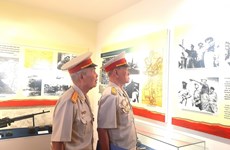Central Highland province to restore Cat Tien site
The Central Highland province of Lam Dong is finding ways to restore the architecture of Cat Tien Holy Land.
The Central Highland province of Lam Dong is finding ways to restore the architecture of Cat Tien Holy Land.
It is coordinating with historians from the Ho Chi Minh City National University and the Vietnam Archaeology Institute to design a project to research the architecture of Cat Tien Holy Land, which is located inside an archaeological site, according to Nguyen Thi Nguyen, Deputy Director of the provincial Department of Culture, Sports and Tourism.
The project aims to rebuild a number of architectural icons at the site to save the tourist site and its development as well as the chance to research its history in the future.
It will also help throw light on a number of issues, such as dates and the hidden treasures of the Cat Tien Holy Land, that are still a matter of debate among historians and experts.
The Cat Tien Archaeological site was excavated in 1991 and recognised as a national relic site in 1998, according to information from the Lam Dong Museum.
Nguyen said: "Archaeologists have already excavated 10ha of the site, while the remaining 70ha of land on the site are still being used by the local people. Before excavations, the site had been illegally dug up by thieves searching for gold and antiques so the site's surface is disordered."
The site consists of temple towers dating back to the 7th or 8th century AD. Archaeologists, however, have found that most of its surface architecture has been damaged. Only some traces of the 3m-high tiled wall still remain.
They remark that the 1.5m structure inside the perimeter of the land had also been built with tiles.
Nguyen said Lam Dong province had invested about 38 billion VND (1.79 million USD) to fund several constructions, including the museum to preserve, protect and display excavated relics.
Currently, the Cat Tien archaeological site has about 1,300 excavated objects, which are temporarily preserved in the Lam Dong Museum.
According to Nguyen, the province is compiling documents to propose that the Ministry of Culture, Sports and Tourism recognise the site as a special national relic.-VNA
It is coordinating with historians from the Ho Chi Minh City National University and the Vietnam Archaeology Institute to design a project to research the architecture of Cat Tien Holy Land, which is located inside an archaeological site, according to Nguyen Thi Nguyen, Deputy Director of the provincial Department of Culture, Sports and Tourism.
The project aims to rebuild a number of architectural icons at the site to save the tourist site and its development as well as the chance to research its history in the future.
It will also help throw light on a number of issues, such as dates and the hidden treasures of the Cat Tien Holy Land, that are still a matter of debate among historians and experts.
The Cat Tien Archaeological site was excavated in 1991 and recognised as a national relic site in 1998, according to information from the Lam Dong Museum.
Nguyen said: "Archaeologists have already excavated 10ha of the site, while the remaining 70ha of land on the site are still being used by the local people. Before excavations, the site had been illegally dug up by thieves searching for gold and antiques so the site's surface is disordered."
The site consists of temple towers dating back to the 7th or 8th century AD. Archaeologists, however, have found that most of its surface architecture has been damaged. Only some traces of the 3m-high tiled wall still remain.
They remark that the 1.5m structure inside the perimeter of the land had also been built with tiles.
Nguyen said Lam Dong province had invested about 38 billion VND (1.79 million USD) to fund several constructions, including the museum to preserve, protect and display excavated relics.
Currently, the Cat Tien archaeological site has about 1,300 excavated objects, which are temporarily preserved in the Lam Dong Museum.
According to Nguyen, the province is compiling documents to propose that the Ministry of Culture, Sports and Tourism recognise the site as a special national relic.-VNA












